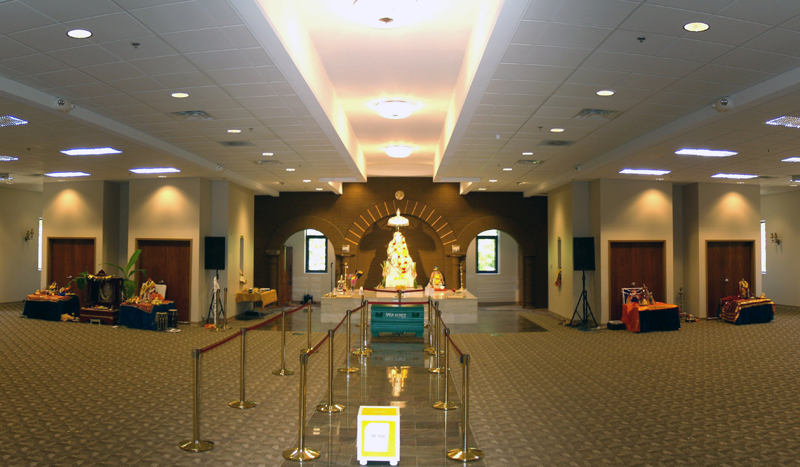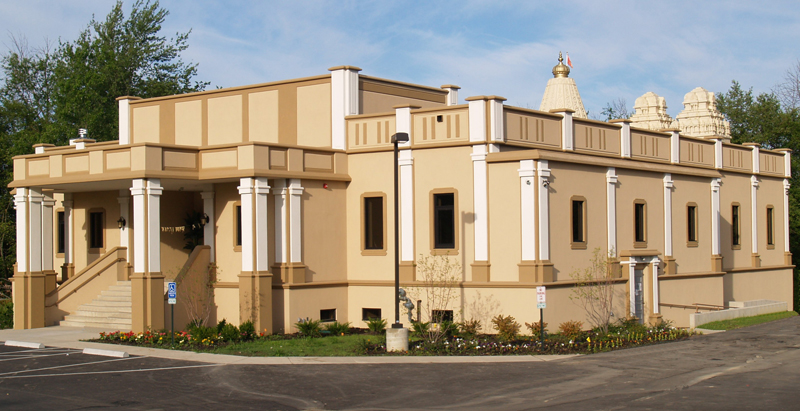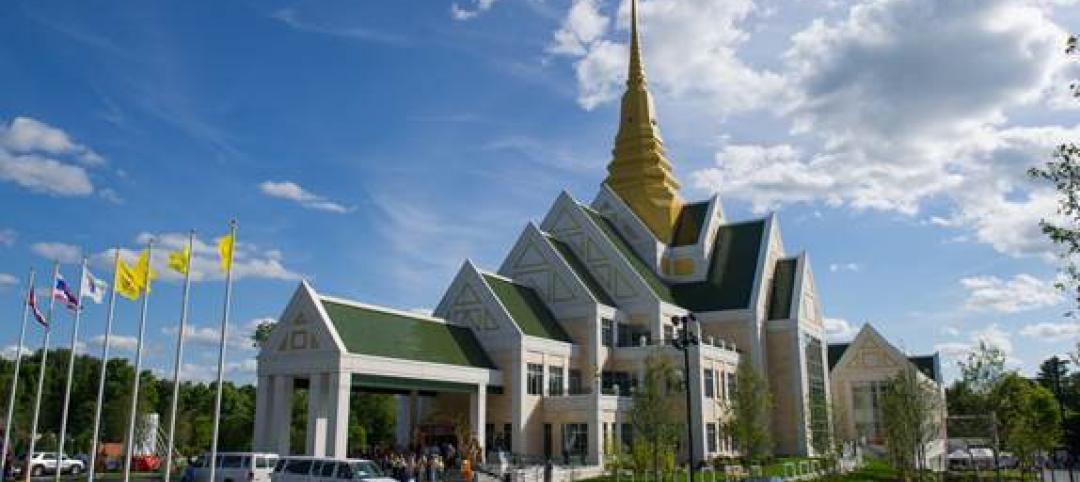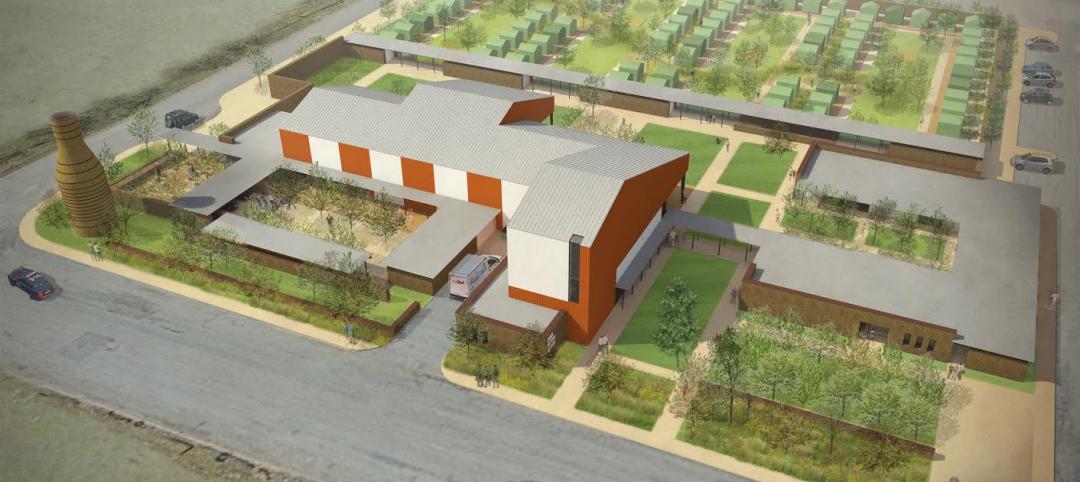Maverick Builders, of Grove City, Ohio, has built numerous churches over the years, some of them metal building systems. In recent times, their business has expanded to include houses of worship for a variety of religions. In 2012, they completed their first temple of Sri Saibaba, a sect related to the Hindu religion, with its origins in 19th century India. There are active devotees in many countries, including the US. In 2000, the Sri Saibaba Temple Society of Central Ohio was founded with its primary goal being the construction of a temple in Lewis Center, OH. It took a decade, but they achieved that goal. Design began in 2010, construction began in 2011, and the temple was completed by April 2012. The temple now regularly welcomes 400 worshippers.
Despite Maverick’s extensive experience in the religious sector, this project posed a few unfamiliar challenges. Some of the challenges related to specific religious requirements of the building, which impacted both design and construction. There were also structural aspects that were uncommon for metal building systems that had to be solved.
The 16,000-sf temple, in the wooded suburbs north of Columbus, OH, utilized a Star Building System. Although it does not look it, it is a single-slope roof structure. Parapet wall extensions of various heights create interest and depth to the exterior elevations. The walls are metal wall panels covered with a multi-colored EIFS finish with special accent features. The overall effect is more like a traditional stone-column structure with brightly colored plaster infill walls. A membrane rubber roof was installed over structural metal decking, supported by the Star structure.
The temple is a two-story building, with a basement level that rises 4 feet above grade. The second level is on a suspended precast concrete floor. This is an atypical condition, as many metal building systems are built as slab-on-grade. Engineering to properly transfer the roof and wall loads to the foundation is a little trickier than normal, and was made more complicated by significant point loads of large ornamental structures at several locations on the roof.
There were a number of unusual design features. Maverick Builders’ owner, Paul McKnight, recalls that some of the interior spaces weren’t located where they would be if designed from a purely architectural standpoint. The beliefs of the congregation required specific compass-orientations for certain rooms. The temple sanctuary had to be oriented correctly, as did the direction of staircase travel, and even the bathroom layout. Both interior and exterior designs feature walkways that circle the building and main prayer hall, which are used as part of the religious ceremonies.
The roof bears several heavy ornamental elements, each of which requires a roof curb and appropriate engineering for the increased load. The clear span pre-engineered rafters were designed to support seven point loads. The largest of these is the 2-ton shikhara, the pyramid-like structure that is the most prominent exterior feature of a Hindu temple. It is located directly over the focal point of the sanctuary.
In addition, the construction schedule needed to be coordinated with the owners so that appropriate blessings and religious rituals could be performed at certain stages of construction, such as when sacred objects were being installed. This sometimes involved dozens of people occupying the site while it was still under construction, a challenging and risky situation that contractors usually like to avoid. McKnight, however, recognized the importance of making these ceremonies possible, “to make sure that everything is blessed properly. It will bring good luck on everyone involved,” he says. “In today’s times, you need all the good luck you can get, so we happily cooperated with all of those requirements.”
There was one crucial phase of construction that could not be performed until the entire building was otherwise complete. The 4000 lb., Italian marble statue of Saibaba, the focal point of the sanctuary, was the last thing to be placed in the building. In order to accomplish this, Maverick had to build a framed opening into the roof directly over the intended location of the statue. It was temporarily sealed for weather tightness during construction. When everything else was complete, the roof was opened, and the statue was lowered in by crane. A domed ceiling was placed over the statue, the roof was permanently sealed, and the large shikhara was installed on the roof.
Maverick Builders was awarded a Master Builder Award for “Best Specialty Building,” presented at Star’s annual national sales meeting.
On the website of the Saibaba Temple Society of Central Ohio, there is a page devoted to construction updates, where it says, “It is often told that being able to participate and contribute in a noble activity like building a temple that will serve several thousand people year after year is a once in a lifetime opportunity.” It appears this may not be true for Maverick Builders, however. Word of the great success of this project has apparently gotten around to other congregations, and there may be more temples and more such opportunities in Maverick’s future.

Project: Sri Saibaba Temple, Lewis Center, Ohio
Design/Builder – Maverick Builders, Inc., Grove City Ohio
Architect – CDI, Design, LLC, (Maverick’s in-house designer)
Building manufacturer – Star Building Systems
Steel erection – Maverick Builders
HVAC – Command Heating
Plumbing – Command Plumbing
Electric – Westlake Electric
Concrete – Eagle Concrete
Framing & drywall – Fry Drywall
Painting – Listing Painting
EIFS – Damron Finish Systems
Roofing – Harmac Roofing
Related Stories
| Jun 17, 2014
Nation's largest Thai Buddhist temple opens near Boston
The $60 million facility built in honor of King Rama IX of Thailand is the largest Thai Buddhist temple outside of Thailand.
| Jun 12, 2014
Austrian university develops 'inflatable' concrete dome method
Constructing a concrete dome is a costly process, but this may change soon. A team from the Vienna University of Technology has developed a method that allows concrete domes to form with the use of air and steel cables instead of expensive, timber supporting structures.
| Jun 10, 2014
Gaudi’s famed cathedral on ice: Dutch students to construct 132-foot ice replica of Sagrada Familia
"Sagrada Familia in Ice" will be built with a mixture of wooden fibers and plain ice that is three times stronger than ice.
| May 29, 2014
7 cost-effective ways to make U.S. infrastructure more resilient
Moving critical elements to higher ground and designing for longer lifespans are just some of the ways cities and governments can make infrastructure more resilient to natural disasters and climate change, writes Richard Cavallaro, President of Skanska USA Civil.
| May 20, 2014
Kinetic Architecture: New book explores innovations in active façades
The book, co-authored by Arup's Russell Fortmeyer, illustrates the various ways architects, consultants, and engineers approach energy and comfort by manipulating air, water, and light through the layers of passive and active building envelope systems.
| May 19, 2014
What can architects learn from nature’s 3.8 billion years of experience?
In a new report, HOK and Biomimicry 3.8 partnered to study how lessons from the temperate broadleaf forest biome, which houses many of the world’s largest population centers, can inform the design of the built environment.
| May 13, 2014
19 industry groups team to promote resilient planning and building materials
The industry associations, with more than 700,000 members generating almost $1 trillion in GDP, have issued a joint statement on resilience, pushing design and building solutions for disaster mitigation.
| May 12, 2014
Lubbock, Texas, to build modern 'tent city' as shelter for homeless
On the five-acre site of a former cotton gin, the High Cotton program provides temporary shelter for Lubbock's homeless population. The facility needs to expand due to increased need, and new plans have been drawn up.
| May 11, 2014
Final call for entries: 2014 Giants 300 survey
BD+C's 2014 Giants 300 survey forms are due Wednesday, May 21. Survey results will be published in our July 2014 issue. The annual Giants 300 Report ranks the top AEC firms in commercial construction, by revenue.
| Apr 29, 2014
USGBC launches real-time green building data dashboard
The online data visualization resource highlights green building data for each state and Washington, D.C.

















